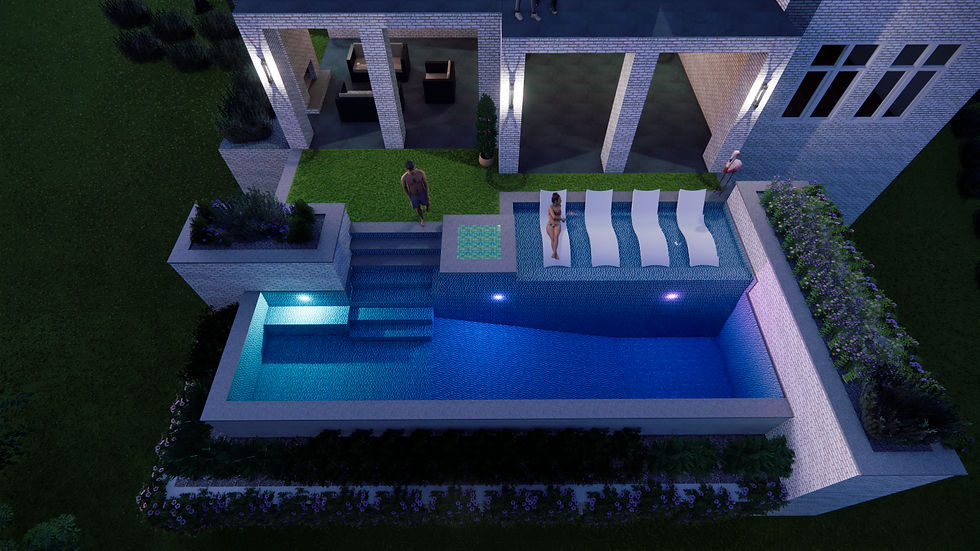How Much Does a Backyard Pool Cost? - Let's Break It Down!
- Masha Carter

- May 2
- 4 min read
One of the most common questions we hear is straightforward: "How much will my backyard pool cost?" While everyone wants a simple answer, the reality is that concrete pool pricing depends on numerous factors that can significantly impact the final investment.
Let's break down what goes into the cost of a premium concrete pool so you can better understand where your money goes and make informed decisions about your project.

The Basics: Understanding Concrete Pool Construction
Concrete pools (also called gunite or shotcrete pools) are known for their durability and unlimited design potential. The construction process involves several key phases:
Design and Engineering: Creating detailed plans that match your vision while addressing site-specific challenges
Excavation: Removing soil and preparing the site
Steel Framework: Installing the steel rebar grid that forms the pool's skeleton
Plumbing and Electrical: Setting up filtration, drainage, and lighting systems
Shotcrete Application: Spraying the concrete mixture around the rebar framework
Waterproofing and Finishing: Applying waterproof membranes and final surface materials
Decking and Landscaping: Completing the surrounding area
Each phase requires skilled labor, quality materials, and proper equipment—all of which contribute to the overall cost.
Cost Factors: What Determines Your Pool's Price Tag
1. Size and Depth
It's straightforward: larger pools require more materials and labor. But the relationship isn't always linear—a pool twice the size won't necessarily cost twice as much, as certain fixed costs remain similar. Consider:
Square footage of the pool surface
Average and maximum depths
Shape complexity (curved designs require more skilled labor)
2. Design Features and Complexity
The beauty of concrete pools is their customization potential, but each feature adds to your investment:
Water features: Waterfalls, fountains, or laminar jets
Special edges: Infinity edges, raised walls, or beach entries
Built-in elements: Tanning ledges, swim-up bars, or in-pool seating
Integrated spas: Adding heated spa sections with jets
Each custom element requires additional engineering, materials, and specialized installation.
3. Interior Finishes
Your pool's interior finish affects both aesthetics and the swimming experience:
Plaster: The standard option, available in various colors
Quartz finishes: More durable than plaster with added shimmer
Pebble finishes: Premium, long-lasting surfaces with natural appearance
Tile: The most expensive but most durable option, with unlimited design potential
Higher-end finishes can significantly increase costs but often reduce long-term maintenance expenses.
4. Decking and Surroundings
The area around your pool dramatically impacts both usability and visual appeal:
Concrete decking: Affordable but with fewer design options
Pavers or natural stone: Higher cost but enhanced aesthetics and often better heat reflection
Coping material: The edge that transitions from pool to deck
Retaining walls or raised sections: Often necessary on sloped properties
Many homeowners underestimate decking costs, which can represent 15-25% of the total project budget.
5. Equipment and Technology
Modern pools benefit from advanced systems that enhance convenience and efficiency:
Filtration systems: Sand, cartridge, or DE filters at varying price points
Sanitization options: Traditional chlorine, salt systems, or advanced oxidation
Heating solutions: Gas heaters, heat pumps, or solar options
Automation systems: Smart controls for scheduling and remote operation
Lighting packages: Standard white lights vs. color-changing LED systems
Investment in quality equipment often pays dividends in reduced operating costs and convenience.
6. Site Conditions and Access
Your property's specific conditions can significantly impact costs:
Soil type: Rocky soil or high water tables require special handling
Slope: Retaining walls and complex engineering for hillside pools
Access: Limited access for equipment may require special machinery
Utilities: Relocating existing lines or upgrading electrical service
These factors may not be obvious during initial planning but can significantly affect your budget.

The Bottom Line: What to Expect
Our concrete pools typically range from $100,000 to $250,000+, depending on the factors outlined above. This investment includes:
Professional design services
All construction phases
Quality materials and craftsmanship
Standard equipment packages
Basic landscaping restoration
Remember that the long-term value of a well-built concrete pool extends beyond the initial cost—these pools can last for decades with proper maintenance, often outlasting other pool types by many years.
Making the Right Investment
When planning your pool project, consider these recommendations:
Prioritize features based on how you'll actually use the pool
Don't skimp on structural elements or equipment quality
Consider phasing certain aesthetic elements if budget is tight
Work with experienced professionals who understand cost implications
Budget for unexpected issues, especially related to site conditions
At Cosmic, we provide detailed proposals that break down all costs so you can make informed decisions about where to invest and where you might scale back.
Ready to Take the Next Step?
Understanding the real costs of a quality concrete pool helps set appropriate expectations from the start. While the investment is significant, the years of enjoyment, increased property value, and ability to create lasting memories make it worthwhile for many homeowners.
Contact our team for a personalized consultation and detailed quote based on your specific needs and property conditions.



Comments